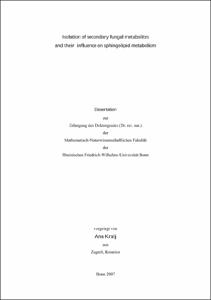Kralj, Ana: Isolation of secondary fungal metabolites and their influence on sphingolipid metabolism. - Bonn, 2007. - Dissertation, Rheinische Friedrich-Wilhelms-Universität Bonn.
Online-Ausgabe in bonndoc: https://nbn-resolving.org/urn:nbn:de:hbz:5N-12702
Online-Ausgabe in bonndoc: https://nbn-resolving.org/urn:nbn:de:hbz:5N-12702
@phdthesis{handle:20.500.11811/3188,
urn: https://nbn-resolving.org/urn:nbn:de:hbz:5N-12702,
author = {{Ana Kralj}},
title = {Isolation of secondary fungal metabolites and their influence on sphingolipid metabolism},
school = {Rheinische Friedrich-Wilhelms-Universität Bonn},
year = 2007,
note = {Development of new drugs, especially in the area of oncological and infectious diseases, represents today one of the most important research fields. The marine environment is a tremendous source of natural products. Drug development is now turning toward potentially more selective ways (e.g. inducement of certain signaling molecules) in disease treatments, especially when concerning cancer. Sphingolipids (SLs) are ubiquitous constituents of eukaryotic cellular membranes that are involved in cell growth, proliferation, differentiation and apoptosis. These sphingolipid-regulated processes are crucial in cancer development and progression. Pharmacological or molecular manipulations of any of the enzymes involved in SL metabolism have been proposed as new strategies in the treatment of cancer or diseases caused by disrupted sphingolipid balance. The toxic effects of some fungal metabolites were related to their ability to interfere with SL metabolism. The aim of this study was the investigation of secondary metabolites produced by marine-derived fungi with cytotoxic properties and the isolation of new compounds with potent biological activity, preferably with the potential to influence sphingolipid metabolism.
Extracts of seven fungal strains, including five algal-derived and two sponge-derived strains, were chemically investigated. This investigation resulted in the isolation and structure elucidation of 29 pure compounds. Four compounds, arugosin G and H, spicellamide A and B, proved to be new. Arugosins G and H, together with arugosins A and B, were isolated from algicolous fungus Emericella nidulans var. acristata. They are benzophenone derivatives, biosynthetically related to xanthones, which showed moderate antitumor activity toward individual tumor cell lines. Cyclohexadepsipeptides spicellamide A and B, isolated from sponge-derived fungus Spicellum roseum, exhibited moderate cytotoxicity in neuroblastoma cells. Bioassay-guided isolation of cytotoxic compounds revealed the presence of cytochalasins from an Arthrinium sacchari extract, of aflatoxins from an Emericella nidulans var. acristata extract and of trichothecenes from a Spicellum roseum extract.
Trichothecenes are cytotoxic compounds that have several inhibitory effects on eukaryotic cells. Tests on sphingolipid metabolism exhibited alterations in the expression of glycosphingolipids by two compounds from trichothecene family, 8-deoxy-trichothecin and trichodermol. In cerebellar neurons and neuroblastoma cells both compounds inhibit lactosylceramide synthase activity and induce an accumulation of glucosylceramide. These data describe a new effect of trichothecenes. However, further studies have to clarify the fate and physiological consequence of accumulated glucosylceramide and also its correlations with known effects of trichothecenes.},
url = {https://hdl.handle.net/20.500.11811/3188}
}
urn: https://nbn-resolving.org/urn:nbn:de:hbz:5N-12702,
author = {{Ana Kralj}},
title = {Isolation of secondary fungal metabolites and their influence on sphingolipid metabolism},
school = {Rheinische Friedrich-Wilhelms-Universität Bonn},
year = 2007,
note = {Development of new drugs, especially in the area of oncological and infectious diseases, represents today one of the most important research fields. The marine environment is a tremendous source of natural products. Drug development is now turning toward potentially more selective ways (e.g. inducement of certain signaling molecules) in disease treatments, especially when concerning cancer. Sphingolipids (SLs) are ubiquitous constituents of eukaryotic cellular membranes that are involved in cell growth, proliferation, differentiation and apoptosis. These sphingolipid-regulated processes are crucial in cancer development and progression. Pharmacological or molecular manipulations of any of the enzymes involved in SL metabolism have been proposed as new strategies in the treatment of cancer or diseases caused by disrupted sphingolipid balance. The toxic effects of some fungal metabolites were related to their ability to interfere with SL metabolism. The aim of this study was the investigation of secondary metabolites produced by marine-derived fungi with cytotoxic properties and the isolation of new compounds with potent biological activity, preferably with the potential to influence sphingolipid metabolism.
Extracts of seven fungal strains, including five algal-derived and two sponge-derived strains, were chemically investigated. This investigation resulted in the isolation and structure elucidation of 29 pure compounds. Four compounds, arugosin G and H, spicellamide A and B, proved to be new. Arugosins G and H, together with arugosins A and B, were isolated from algicolous fungus Emericella nidulans var. acristata. They are benzophenone derivatives, biosynthetically related to xanthones, which showed moderate antitumor activity toward individual tumor cell lines. Cyclohexadepsipeptides spicellamide A and B, isolated from sponge-derived fungus Spicellum roseum, exhibited moderate cytotoxicity in neuroblastoma cells. Bioassay-guided isolation of cytotoxic compounds revealed the presence of cytochalasins from an Arthrinium sacchari extract, of aflatoxins from an Emericella nidulans var. acristata extract and of trichothecenes from a Spicellum roseum extract.
Trichothecenes are cytotoxic compounds that have several inhibitory effects on eukaryotic cells. Tests on sphingolipid metabolism exhibited alterations in the expression of glycosphingolipids by two compounds from trichothecene family, 8-deoxy-trichothecin and trichodermol. In cerebellar neurons and neuroblastoma cells both compounds inhibit lactosylceramide synthase activity and induce an accumulation of glucosylceramide. These data describe a new effect of trichothecenes. However, further studies have to clarify the fate and physiological consequence of accumulated glucosylceramide and also its correlations with known effects of trichothecenes.},
url = {https://hdl.handle.net/20.500.11811/3188}
}






